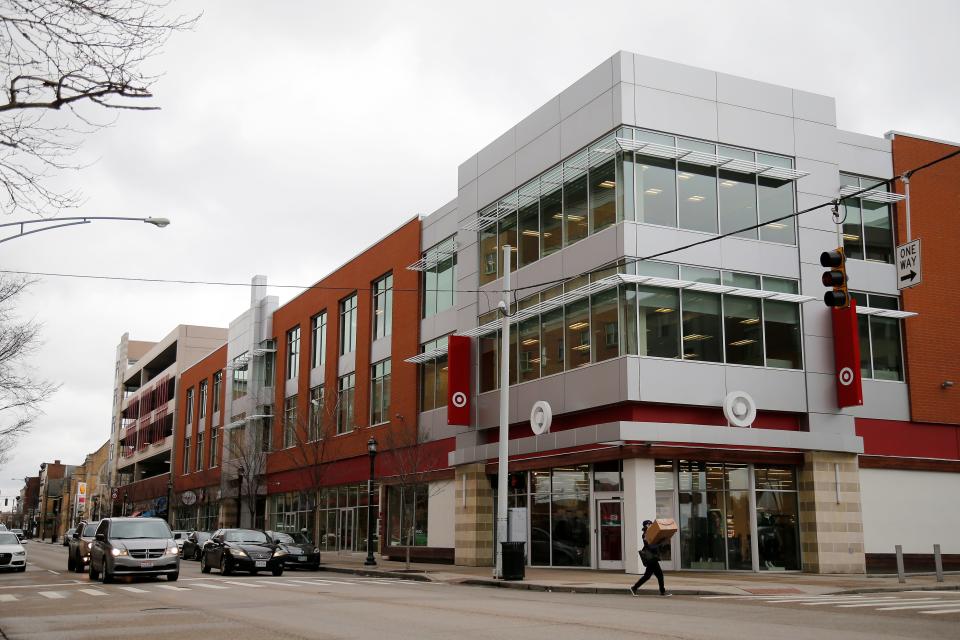Downtown Cincinnati residents and workers want a Target. Could they get one?

This article is part of The Enquirer's Future of Downtown series.
For those who live or work in downtown Cincinnati, there's one place they're all dreaming of: a Target store.
That's what The Enquirer learned from a survey about Downtown's retail scene and what's currently missing, Target was at the top of the list of big-box retailers that locals want.
Over 20 years ago, downtown Cincinnati shoppers could visit Macy's, T.J. Maxx and Saks Fifth Avenue. They've all closed. A few high-end stores serve customers looking for custom-fit hats, tailored suits, or holiday jewelry, but gone are the days of Downtown's one-stop-shop department stores.
Unless Downtown gets a Target, that is. Demand for such a store is increasing as more residents move Downtown and the neighborhood shifts from a job hub to a lifestyle center. Eighty percent of Enquirer survey respondents said that Target was the store they most wanted to attract. For comparison, 40% also said opening replacement T.J. Maxx would benefit the area.
"People will tell you all those stores failed 10 years ago, but that was before downtown was a big neighborhood," said Kathleen Norris, managing principal of Urban Fast Forward, an Over-the-Rhine-based real estate consultancy. "In the very near future, we should be able to easily attract chains to our large commercial units."
Now, with just under 6,000 residents making an average of $82,000 a year, Downtown is dense and bigger in population than half of Cincinnati's other 51 neighborhoods. Plus, more than 80,000 people still work in Downtown during the week, according to the Cincinnati USA Regional Chamber.
So how likely is it that an urban Target would open in the city center to support these people?
Minneapolis-based Target didn't respond to multiple requests for comment or details on the neighborhood criteria needed to build a new store. But the pandemic probably upended big-box retailers' expansion goals in the same way it forced downtowns to reinvent themselves, Norris added. "Their criteria are changing because urban locations are changing right now too," she said. "Target is trying to catch up just like everyone else is."
National retailers have spent two decades moving away from urban settings, added Terry Ohnmeis, senior director of retail services at Cincinnati brokerage Cushman & Wakefield. That trend wasn't specific to Cincinnati. What is a good sign for the future of retail is all the activity happening now. "We have some incredible Cincinnati-based landlords and out-of-town developers making significant investments in Downtown," Ohnmeis said.
As more places to shop and eat come online in those new properties, larger retailers will hopefully take notice, Norris said. Retail begets retail. "That will propel us toward the tipping point for merchants like Target."
Learning from Clifton Heights and its small-format store

In 2017, Target opened one of its small-format stores near the University of Cincinnati at the base of an apartment building on Calhoun Street. It's 17,500 square feet and includes dormitory furniture and accessories for students, as well as basic groceries and everyday items. (This store serves the CUF district of Clifton Heights, University Heights and Fairview, which as of 2020, boasted 19,000 people. The median income was $26,000 for the five census tracts that surround campus.)
Target has nearly 2,000 stores in its portfolio − one in nearby Newport − and just 170 are built in this small format. Earlier this fall, though, Target announced the closure of over a dozen locations, many of which were small-format stores, leading retail industry experts to question whether or not the model is working. One of the biggest challenges? Theft and retail crime.
But this can't be the only cause for Target's overall store-count shrinkage. Urban shoppers trekking to the store on foot probably aren't buying as much per visit as suburban shoppers with cars. That affects the store's individual profit margins. Also, stocking higher inventory and conducting online fulfillment orders aren't as easy at small-format locations.
Not only that, but Target as a company is seeing sales fall right now, despite its stock being up. People are spending less on discretionary items. Why? Inflation is discouraging people from buying little more than the basic necessities.
Still, the opening of a 10,000-square-foot location in downtown Pittsburgh this summer signals that opening one in a central business district like Cincinnati's isn't so far-fetched. Downtown Pittsburgh has a similarly-sized residential population, and about 40,000 people work there every day, according to the Pittsburgh Downtown Partnership.
So would Target now take a chance on a place like downtown Cincinnati if sales are down, costs are rising and retail crime is more popular than ever?
Not yet, argues Carl Goertemoeller, executive director of the University of Cincinnati's Real Estate Center. The real problem is the lack of foot traffic in the area.
"The influx of 1,500 more residential units coming downtown just isn't enough to move the needle," he said. "You need 20 times that as a minimum threshold for bigger retailers."
Cushman & Wakefield's Ohnmeis argued that Downtown hotel guests also play a vital role in attracting both small and big businesses. "Those are people without a kitchen and fresh wallets that are traveling on weekdays that bring a tremendous amount of foot traffic downtown," he said. "That's why boosting business travel with a new convention center hotel is so important."
For 16 years, the University of Cincinnati's Goertemoeller served as senior vice president of real estate for Macy's. He doesn't believe Macy's will take another chance on downtown Cincinnati after leaving its flagship location in 2018. There are three Macy's stores in Greater Cincinnati including the closest one at Kenwood Towne Center.
Combined with the exodus of T.J. Maxx in 2014 and Saks last winter, the real estate expert thinks other major large-format retailers will hesitate to move to the city center too.
"Maybe in two years we'll be in a better position to sell downtown to national retailers," Goertemoeller concluded. "But if a retailer is big enough, they'll go to Kenwood."
How The Enquirer survey was conducted
The Enquirer distributed a private survey from the end of October through November via the Downtown Residents' Council and the Cincinnati USA Regional Chamber. We received 80 responses.
This article originally appeared on Cincinnati Enquirer: Would Target open in downtown Cincinnati? Where to shop downtown

